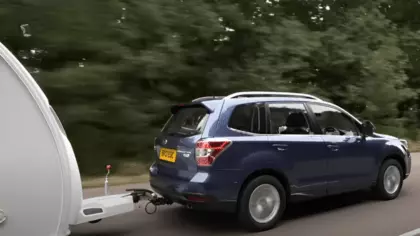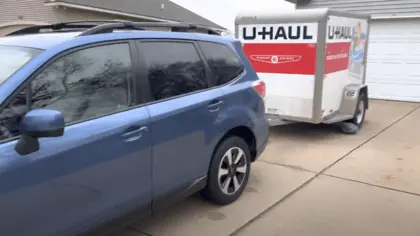The Subaru Forester, introduced in 1997, is superbly designed for towing and is also equipped with proper built-in safety features. It is a reliable, highly fuel-efficient, and all-wheel drive car that combines the characteristics of a SUV’s versatile ruggedness and station wagon’s comfort. With proper setup, the Forester can easily tow or pull small trailers, lightweight boats, and similar loads up to 1,500 lbs., and is suited for towing over uneven surfaces as well. However, for towing heavier loads, you need to look at Subaru’s Outback or Ascent models. Some Outback models tow up to 3,500 lbs., whereas the Ascent’s peak capacity is 5,000 lbs. with proper arrangement.
The Forester can accommodate up to 5 persons with a larger goods-holding space than most other SUVs. Its 2.5-liter and 182 horsepower engine provide 176 lb-ft torque. This is enough power for problem-free tugging of an appropriate trailer. Its 6-speed manual transmission allows easy control over its driving speed. So it is an ideal car for family camping trips with towing.
Safety and optimization of Forester’s towing capacity

The towing capacity of any vehicle can be categorized into two types:
(a) Towing capacity with brakes – the maximum rated load or weight that any vehicle can pull safely when the trailer has its own braking facility. This is the rating that is mostly used to define the towing capacity.
(b) Towing capacity without brakes – the maximum weight that the vehicle can tow safely when the trailer does not have its own braking facility. The unbraked towing capacity is always less than the braked one.
All the Forester models, except Forester Wilderness, have 1,500 lbs. towing capacity. Only the Forester Wilderness model has 3,000 lbs. capacity. For unbraked towing ability, all Forester models are rated at 1,000 lbs.
The Forester incorporates high-level safety features. It has already gained many safety awards. Traveling in it is likely to be quite adventurous and comfortable. Also, with the Forester, towing or tugging a trailer isn’t really tough or dreadful.
Yet the overall preparations and the driver’s alertness are of prime importance when pulling a trailer. So, for safe and optimized towing some essential hints to be considered before starting out with an attached trailer are given below:
- Absolutely never, ever tow from your bumper – using a hitch is vitally important for safety.
- Use only a well-matched hitch – this will ensure that the hitch and trailer will be fully adapted for a safe and smooth ride.
- Always opt for using towing parts from Original Equipment Manufacturers– they guarantee proper fitment and long-lasting quality.
- Thoroughly inspect your Forester to the prevention of accidents and ensure a hassle-free journey – check the conditions, and take needed actions, if required, of all the tires, tire treads, hitch, brakes, lights, hoses, belts, fluids, wiring, etc. before starting off. You can then sidestep any agonizing issue.
- Get an experienced mechanic to thoroughly re-check the entire setup and arrangement of your towing vehicle and trailer – with safety on top of your mind.
- Practice skillful reversing of the trailer – a common anomaly that can occur when towing is moving of a trailer in the reverse direction. You also need to clearly understand how the trailer will behave when you turn the wheel. So you need to practice that beforehand in an open, safe space. This practice will make you more confident and won’t be so difficult.
- The pulling vehicle’s capacities as well as the driver’s abilities must be ensured fully well at the highest possible level – driving skills are vitally important in this case.
- Check your Forester’s user manual– consider all the abilities, specialties, and drawbacks of your vehicle to make the towing experience as easy and efficient as possible.
- Upgrading the vehicle’s exhaust system with new air filters can help enhance towing capacity.
- Put on padded gloves and protective shoes for your safety –trailer operation can cause injuries if the hitch stand gets collapsed and if your hands are caught in the winch gear.
- Always ensure that the chosen towing route is as safe as possible in all respects.
- When towing, remain alert to shun jerking the trailer in any way as it puts excess strain on the hitch and other towing elements.
- Always apply brakes in good time –remember that more load on the vehicle creates more pressure, and that means the brakes will have to work harder and will need more time to slow down from whatever may be the speed. For safe braking, maintain extra distance between yourself and the vehicle ahead than what may be normal, more so when you descend any downward path.
- Always be careful with braking and restrain slamming actions with brakes to prevent accident.
- Shift to a lower gear when applying brakes –more pressure on the brakes causes lower responsiveness. Shifting into a lower gear reduces this pressure. Practice ‘down shifting of gear’ beforehand in an open, safe place to get fully familiarized with it.
- Plan on keeping slow and steady speed throughout the journey– focus on pleasure of the trip and not reaching anywhere hastily, meaning ensure slow driving, slow acceleration and slow braking.
- Keep your maximum speed to within 55 miles per hour; going faster will bring the hazard of losing control over both your Forester and the trailer.
- Whenever you need to park, try to do so on flat ground.
- Utilize the parking brake to freeze the trailer wheels for safe loading and/or unloading.
Hopefully, towing will be quite enjoyable if you follow the above steps to verify your readiness and preparations for a well-worth traveling experience.
Upgraded towing assistance features on newer Subaru Forester models
The latest models of the Forester are fitted with some top-class valuable towing enhancement features as given below:
- DriverFocus™ Distraction Mitigation System.It is a safety system that alerts the driver whenever he gets distracted with his attention on the road.
- Anti-lock braking system (ABS) for all four wheels.This ABS ensures that the brakes will function in the intended manner when the need arise, such as when a trailer is being towed.
- Symmetrical All-Wheel Drive system. This is a standardized system that delivers magnificent traction ability for towing in poor weather conditions. It is designed to send power to all four wheels at the same time for maximized traction and acceleration abilities.
- X-MODE®.This is another feature that pushes up engine performance with ensured high transmission ratio.
- Eyesight® Driver Assist Technology. This safety feature incorporates advanced-level adaptation cruise control for lane centering, collision prevention braking, and warnings for lane departure and swaying.
Damages resulting from towing

Some damage is most likely to happen from towing – the extent depending on the towing capacity and what’s being towed. Towing certainly exerts extra pressure on the towing vehicle’s engine and brakes and thereby causes gradual wearing down of those.
Towing gradually speeds up the engine’s corrosion. Always ensure that the pulling vehicle’s engine and brakes have the full capacity for whatever has to be towed. When you want to keep the wear and tear on the tugging vehicle at the minimum, then consider the following factors:
- Inadequate pulling power – towing car’s engine and transmission must be fully matched to what needs to be towed. So, first verify the vehicle’s towing ability from the user’s manual.
- Uneven or unstable trailer – you need to sustain the trailer’s balance such that it remains well-centered when being pulled without excess drag on any one side. When a trailer tilts onto one side while being tugged, it can easily cause substantial damage to the hitch by swaying side to side and also becoming a likely reason of accident.
- Insufficient capacity of brakes – with the added load of a trailer, this inadequacy will definitely lead to failure of timely stopping with potential hazard of accident. Excess exertion on the use of brakes can damage the brake pads and the rotors.
Questions and Answers
1. Does the Subaru Forester have rough road traveling abilities?
Yes, the Subaru Forester can travel over rough or irregular surfaces. However, it cannot be considered to be well-suited for that, compared to some of the other vehicles in its class.
2. Is a Subaru Forester fit for driving over sand?
Indeed, the Subaru Forester can drive over sandy surfaces. However, it isn’t very suitable for being driven over sand with a load of more than 1,000 lbs.
3. How much is the ground clearance height for the Subaru Forester?
The Subaru Forester has a ground clearance of 8.7 inches. This allows it to be easily driven over objects or obstacles with heights of up to six inches from the ground surface.
Conclusion
There are many good reasons to familiarize yourself with your Subaru Forester’s towing capacity. When you tug a trailer with various useful items and even toys for children, your vacation adventures can feel so much joyous.
Your Forester can provide years of thrill, pleasure and fun. So plan your camping trips for enhanced adventurous experience – while remaining within the safety limits of your Forester. When you skillfully manage your towing it can be a source of great enjoyment based on the designed capabilities of your Subaru Forester.
Functionally, the Subaru Forester is quite suitable for towing because it has an all-wheel drive system that makes it ideal for stable driving even on snow-covered roads, and its fuel consumption is about 26 mpg when driving within city and 33 mpg on highways.

